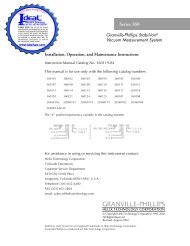Leybold D 2,5 E, D 2.5 E - Ideal Vacuum Products, LLC
Leybold D 2,5 E, D 2.5 E - Ideal Vacuum Products, LLC
Leybold D 2,5 E, D 2.5 E - Ideal Vacuum Products, LLC
Create successful ePaper yourself
Turn your PDF publications into a flip-book with our unique Google optimized e-Paper software.
Warning' Before operating the TRIVAC E with atmospheric gas ballast (optional) check first compatibility with the<br />
pumped media so as to avoid hazardous conditions during operation right from the start.<br />
• Before commissioning the TRIVAC E. make sure thaI the media which are to be pumped are compatible<br />
with each other so as to avoid hazardous situations.<br />
All relevant safely standards and regulations must be observed.<br />
• 1t is recommended to always operate the TRIVAC E with a suitable exhaust line which is properly<br />
connected. It must slope down and away from the pump.<br />
• When moving the TRIVAC E always use the allowed means.<br />
A lifting eye is provided as standard on the pump.<br />
Caution Failure to observe the following precautions could result In damage to the pump:<br />
Note<br />
• Do not allow the ingestion of small objects (screws, nuts, washers, pieces of wire, etc.)<br />
through the inlet port. Always use the screen which is supplied with every pump.<br />
• Do not use the pump for applications that produce abrasive or adhesive powders or<br />
condensable vapours that can leave adhesive or high viscosity deposits. Please contact <strong>Leybold</strong> Sates<br />
Of Service to select a suitable separator. Also pease contact <strong>Leybold</strong> Sales or Service when planning<br />
to pump vapours other than water vapour.<br />
• This pump is suited for pumping water vapour within the specified water vapour tolerance limits.<br />
• Avoid vapours that can condense into liquids upon compression inside the pump, if these substances<br />
exceed the vapour tolerance of the pump (> 25 mbar for water vapour).<br />
• Before pumping vapours, the TRIVAC E should have attained its operating temperature, and the gas<br />
ballast should be set to position I • III (position 0 = closed, position 3 = max. water vapour tolerance,<br />
30 mbar).<br />
The pump will have attained its operating temperature about 30 minutes after starting the pump. During<br />
this time the pump should be separated from the process, by a valve in the intake line, for example.<br />
• In the case of wet processes we recommend the installation of liquid separators upstream and down·<br />
stream of the pump as well as the use of the gas ballast.<br />
• The exhaust line should be laid so that it slopes down and away from the pump so as to prevent con·<br />
densate from backstreaming into the pump. For this preferably use the flange on the side of the motor.<br />
• The entry of particles and fluids must be avoided under all circumstances.<br />
• Reactive or aggressive substances in the pump chamber may impair the operating oil or modify it.<br />
In addition, such substances may be incompatible with the materials of the pump (Viton, grey cast iron,<br />
aluminium, steel, resins, glass etc.).<br />
• Corrosion, deposits and cracking of oil within the pump are not allowed.<br />
This Information will help the operator to obtain the best performance from the equipment:<br />
• Normal amounts of humidity within the range of the pump's vapour tolerance will not significantly affect<br />
pump performance when the gas ballast is active. Preferably use the exhaust flange located on the side<br />
of the motor.<br />
GA 01 .602/1 .02·03101 5

















